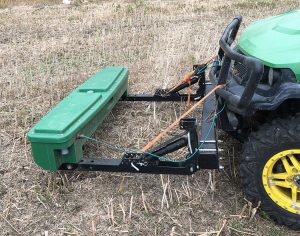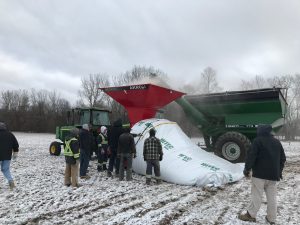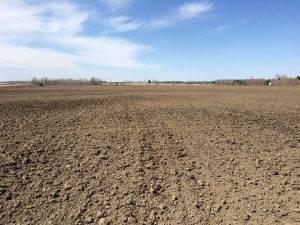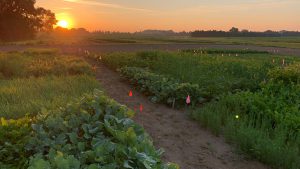Field observations
PREPARING FOR SPRING 2021
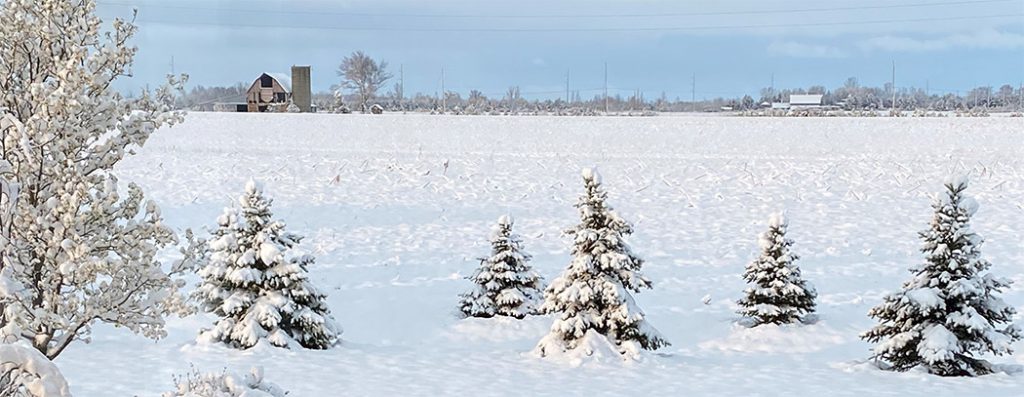
April 30, 2021
Cold, wet and in some cases snowy weather has stopped spring field work and planting by mid week. Damage inspection from the below zero temperatures experienced midweek had farmers and agronomists checking wheat stand, alfalfa, and trees. Cold air temperature has also removed heat out of the soil and soil temperatures have dropped, slowing germination and emergence of any seeded crop in the past two weeks.
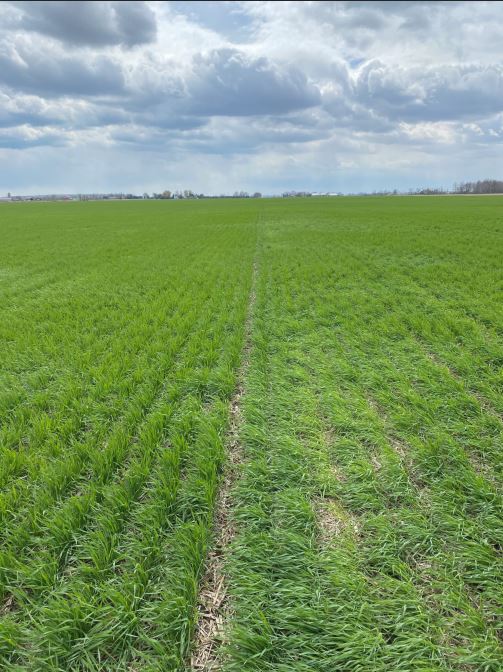
Cereals
Snow fell on most areas of the province this past week, in varying amounts. Thunder Bay received seven inches and parts of the Niagara region received 8.5 inches. The snow should not affect cereal growth very much, and in some cases where the snow fell and stuck around during the freezing temperatures, could be considered an insulating blanket of protection for the growing crop. Unfortunately, it did not stick around to protect the crop the next day as daytime temperatures and sunlight melted most of the snow on the fields.
Frost, snow, and cold temperatures this past week have raised concerns of damage occurring to the winter wheat crop. Last year in mid-May in many locations, temperatures were at -3° C for three hours. Two days later, it was observed that the leaf margins had some browning and some purpling on the leaf, which is slight leaf damage. No damage was noted to the growing point and leaf damage was very minor. Areas to the north indicated temperatures at -7° C, and much more damage was expected; but it depended on the crop growth stage as the crop can take cold temperatures when in the tiller stage.
This past Wednesday and Thursday, evening temperatures dipped to -5° C for multiple hours feeling like -11° C in the Guelph area for a few hours overnight, with no snow cover. After a few days, assessments will need to be done to ensure the crop has recovered from the cold. If there is no new growth out of the main stem that is an indicator of trouble. If you can slice the plant apart and find the head, it should be a light greenish colour, and feel firm. If the main stem head is dead, the tillers will come into play and there should still be a yield; it will be lower than if the main head was functioning but it will not be a complete crop failure.
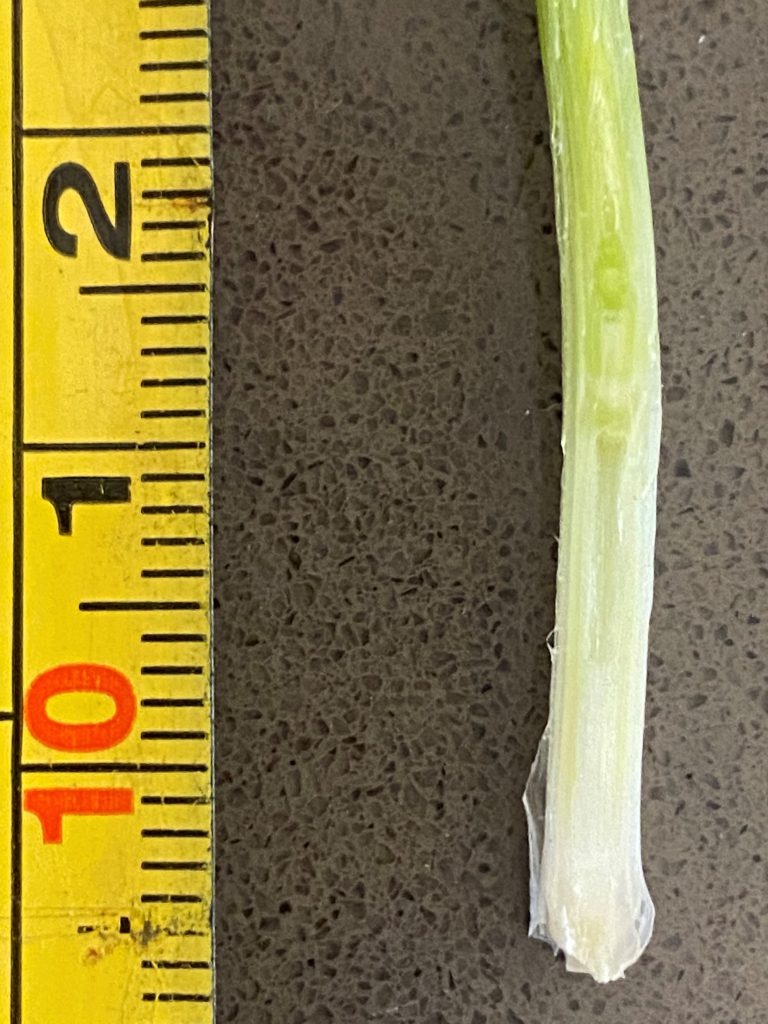
FIRST NODE DETECTABLE.
Fields that do recover will need to still be watched for septoria and powdery mildew which are still being found in fields and may need a fungicide application if the disease is being found especially on new growth.
There have been many questions about spraying in cold weather. Be aware of daytime temperatures as well as nighttime temperatures. Plants need to be active and metabolizing for herbicides and nitrogen to not cause plant damage after cold temperatures. Weeds that have been weakened by frost also need some time to recover for the herbicide to work effectively. Ideally, aim for 3° C above freezing the day before spraying, the day of spraying, and the day after spraying. With the heavy frost that many received, it will not hurt to err on the side of caution and ensure plants are actively growing prior to application.
Corn and soybeans
A few acres of corn and soybeans have been planted across the province. When beginning to plant corn and soybeans, pay particular attention to temperature forecasts. Ideally, a warm rain should be in the forecast for an optimum start. The highest yield potential for crops is when the seed is still in the bag. Aim to have crops go into the ground in the best conditions possible, paying attention to future weather patterns.
The survivability rate for corn and soybeans that were planted and then experienced this week’s cold will depend on a few factors: length of exposure to cold, stage of the plant, and temperature. In corn, the growing point is typically below ground until the V5 stage, defined as a corn plant with five leaves that have visible collars. Corn at this stage should take some cold prior to being killed. Soybeans are more susceptible to a killing frost than corn in the spring, due to the location of the growing point. The growing point for soybeans is above ground and exposed as soon as the cotyledons emerge. After this cold stretch, it will be well worth your time to scout any fields that were planted and emerging looking for damage. Typical damage after a frost when the sun comes out is green tissue turning black or very dark green; this would indicate the plant cells were damaged as the water in the cell turned to ice and the plant cell exploded (cell disruption). That tissue will not regrow, but it may only be on the edge or top leaf. Be sure to check the growing point for damage and scout again within a few days to assess if the plants continue to produce new tissue.
Other
Some changes have been made to Agricorp program deadlines this year. Upcoming deadlines are May 31: deadline to apply/make changes/cancel spring-seeded Grains & Oilseeds.
If you still have not pulled your planter out of the shed here are some tips for getting ready for spring planting.
April 16, 2021
Winter wheat has greened up across the province with many fields receiving their first shot of nitrogen these past couple of days. Majority of fields look outstanding this year with a mild winter and a spring that had limited freeze thaw damage. Spring cereal planting has had a great start the last few weeks with ideal conditions. Soybean planting has out paced corn planting with both crops just starting to be put in the ground. This is likely one of the earliest starts yet.
Winter wheat
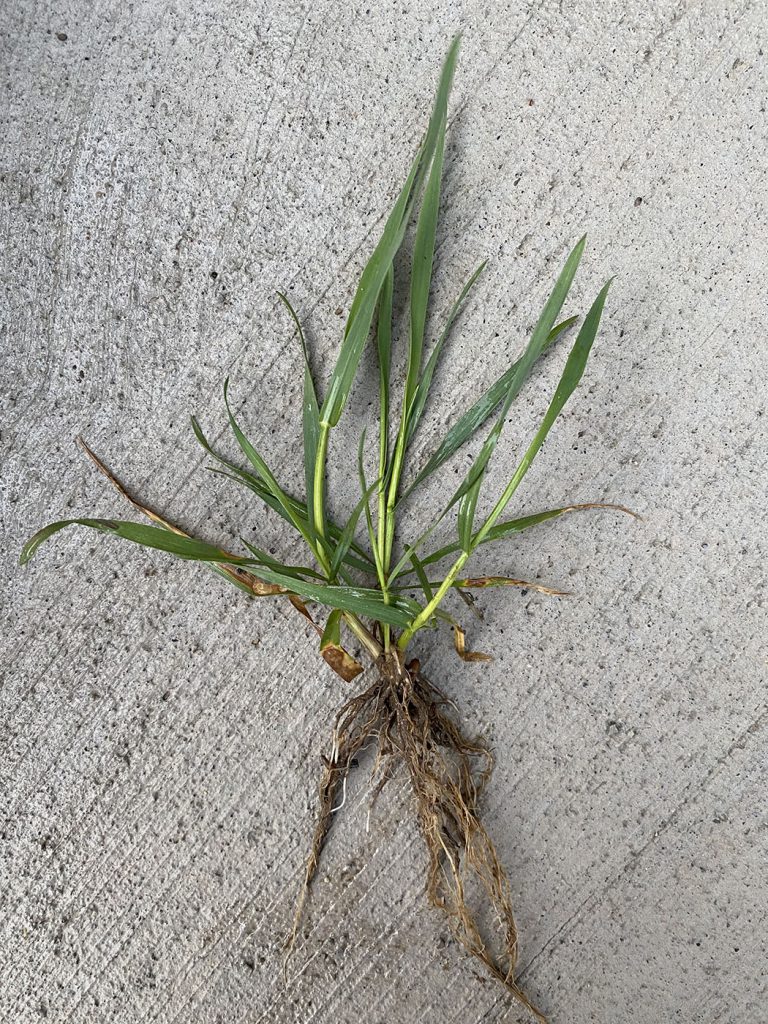
If it was planned that wheat was going to get two applications of Nitrogen (N), much of the acreage has received the first application. There have been some reports of some delays in fertilizer available, this due to the early spring and vessel logistics. At this point it is nothing significant and should clear up with the wet week that we have experienced.
Sulphur (S) is a required nutrient for plant growth. As there is less sulfur being deposited from the atmosphere, our crops have been showing more deficiencies over the years. If you are not using sulfur and need to prove its use to yourself, one of the best ways is to test it, is to do a split field or test strips. Typically, lower organic matter, sandy soils see a higher response, but crop response has been measured on all soil types. The current recommendation from OMAFRA for winter wheat is 10lb/ac of S. Although it is important to note that the higher the N rate, the higher the S rate should be. Ratios of 10:1 to 8:1 are a good guideline but adjusted based on local needs.
Grain Farmers of Ontario is currently investing in further sulphur rate research with John Lauzon at the University of Guelph, more information on the on-going project can be found here.
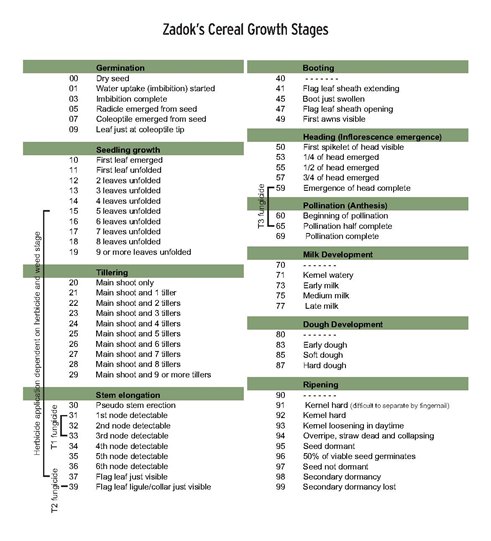
Some disease has been seen (Powdery mildew and Septoria) in lush canopies. Most of the disease is being found on older leaves, it’s important to keep an eye on fields to assess if the disease is moving up the canopy to the newer growth. With dense canopies and cooler damp weather, it may be including a fungicide application. With the dense canopy and timely nitrogen applications many farmers will also be considering a Plant Growth Regulator (PGR). For PGR timing and more information about PGRs click here. Be sure to read and follow the labels for tank mixes and temperatures, paying particular attention to optimal timing.
Grain Farmers of Ontario has two agronomists: Marty (senior agronomist) and Laura (agronomist). Both have gone out into their fields to give an update on wheat staging in their respective areas.
Herbicides can generally be applied between the 3rd leaf and just before flag leaf (Growth Stage Z13-37), check the label carefully as some labels only recommended certain application timing windows. Timing of weed size is critical for the best control of weeds. Also watch spring temperatures; an application on plants during cold temperatures will cause stress on the plant. Herbicides need to be metabolized by the plant, additional stress, such as a frost, can cause added damage to the developing grain head when the plant is in the early stages of development (GS 31-37). Applications to actively growing plants is best for weed control and the health of your plants.
Timing is everything. Read the pesticide label, follow the recommendations and work within the correct window. Recommendation timings and application rates are listed for your benefit to ensure you have the most success with the product.
To learn more about overall management of spring cereals watch our GrainTALK webinar from April 2020.
Other
As of March 31, 2021 according to the Canadian Drought Monitor most of the growing regions in Ontario were classified as abnormally dry, some areas as moderate drought and a pocket in Northwestern Ontario marked as severe drought. You can find the map, and read more here.
As we approach the spring rush, please keep your mental health in mind and reach out for support if needed.
With kids across Ontario being home indefinitely from school, please watch for them in yards, barns, and other areas as we head toward spring planting.
To be prepared this spring with COVID-19 restrictions and delays, please keep in contact with your crop and equipment suppliers and have your supplies on hand as soon as you can receive. Keeping parts on hand reduces the down time for your equipment and limits any delays in sourcing products.
April 9, 2021
Dry spring conditions have allowed for good spring cereal planting across the province over the past couple of weeks. Also, some corn and soybean farmers have hit the ground to either test out their equipment or to test out the theory of plant when it is fit, no matter what the calendar says. Manure and fertilizer are being applied when the conditions allow. Now is a great time to make sure that your spring supplies are in the shed and the planter is ready to hit the field.
We recently asked the field crop specialists at the Ontario Ministry of Agriculture, Food and Rural Affairs (OMAFRA) some timely spring planting questions.
- If we experience an early, dry spring what should farmers do?
- What considerations should farmers make prior to getting the planter out?
- What risks do farmers take on by planting too early?
Corn
“There are risks to planting ultra-early (early-mid April) if the weather goes backwards for an extended period of time afterwards with population, vigour, stand uniformity being impacted or if we receive a late spring frost and corn is more advanced, especially on higher frost risk soils/area,” says Ben Rosser, OMAFRA corn specialist.
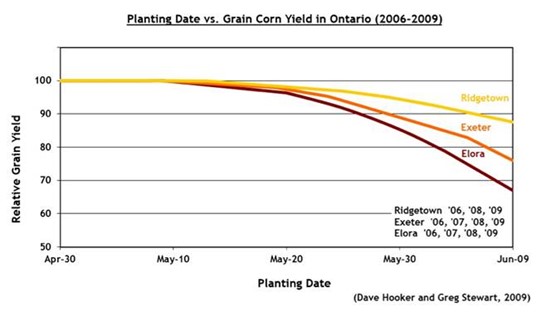
If farmers are planting normal maturity hybrids for the area where planting is taking place, Rosser says that there would not be an expected additional yield response by planting ultra-early. He does note though that, “one exception may be if we receive unseasonably warm temperatures for an extended period (one to two weeks) and receive appreciably more CHU than normal due to this weather.”
The Ontario Corn Performance trials show that pushing maturity in years with above average CHU accumulation can provide significant yield response, however, in years with below average CHU accumulation, yield response to maturity is flat (maybe even a slight penalty for longer maturity corn frosted well before maturity) but longer day corn has much higher drying bills.“The challenge is we don’t know at this point what our final CHU accumulation will be.If you can capture well above normal CHU early on, perhaps you could take a risk by pushing maturity with some early planted corn.”
If a farmer does decide to plant ultra-early Rosser, says they should only do so on a very small portion of overall acres.
| CHU Zone | Switch Date |
| >3,200 | May 30 to Early June |
| 2,800-3,200 | May 20-25 |
| <2,800 | May 15-20 |
MATURITY OF ADAPTED GRAIN CORN HYBRIDS. (PUB 811,
AGRONOMY GUIDE FOR FIELD CROPS)
Tolerance to risks depends on a few factors.According to Rosser, farm, grain handling, end use (delivering to elevator, drying at home, feeding to livestock at home, storing as high moisture corn), and your ability to get on fields late in the season should all be considered. Essentially, farmers should talk to their seed provider prior to making any early planting decisions, as certain hybrids can handle various stresses differently than others and planting hybrids that have demonstrated cold vigour for early planting conditions would be beneficial.
If it turns into a cold, wet spring Rosser notes there are risks in yield loss, low test weights, weak corn, and higher drying charges. In general, he says, “yield potential of a given hybrid starts to decline the later it is planted, but past Ontario research suggests there is some buffer where yield potential remains high. It begins dropping off mid-May. The speed of the drop off depends on where you are in the province -earlier and faster for shorter season areas.”
This work is being repeated by the University of Guelph and OMAFRA with Grain Farmers of Ontario funding for both corn and soybeans starting this year.
“At some point, maturity has to be reduced to account for lost growing CHU. These switch dates are based on data which balances yield benefit of full season hybrids with extra costs of drying and risks of downgrades (light test weight, fines). Switch dates are when costs of full season hybrids outweigh the benefits, and it is more economical to reduce maturity, 100 CHU per week starting on these dates is recommended,” says Rosser.
Soybeans
“Planting date is an important management tool to maximize yield potential. Generally, early planted soybeans (late April to early May) yield more than soybeans planted in late May. June planted soybeans usually yield less. Soybean planting should be initiated based on seedbed conditions, the weather forecast for 48 hours after planting and to some extent calendar date. Since soybeans will be destroyed by a killing frost once they have emerged, ultra-early planting (before April 15th) is problematic in Ontario,” says Horst Bohner, OMAFRA soybean specialist.
Plant stands are a consideration when planting early. “Lower plant stands are common with early planting since soils are cooler. It is critical to have a good seedbed. Soybeans should always be planted into fit soils regardless of the planting date. If significant rainfall is forecasted, wait until conditions improve before planting. A cold rain immediately after seeding can impact emergence. Yield response to planting date will vary depending on the growing season and the maturity group of the variety. The key to getting the highest yield possible when planting early is to select a variety that is relatively long for a given area (0.5 MG). Planting an adapted or a short season variety early does not consistently increase yields compared to a more normal planting window.”
Bohner does say there is good news if the weather delays planting soybeans. “Since the majority of yield is ‘made’ in July and August, late planted fields can do very well if the remainder of the growing season is good. Since soybeans adapt (within reason) to the growing season because they are daylength sensitive it is not necessary to switch varieties unless planting is delayed to late June or July.”
If farmers are considering switching Bohner notesthe main purpose in switching to an earlier maturity group variety is to ensure that the soybeans can finish before a killing frost in the fall.” Since late planted fields have shorter plants that do not branch as much, Bohner recommends increasing the seeding rate to maximize yield potential.
“The importance of soil fertility for high yielding soybeans is sometimes overlooked. High yielding soybeans require large amounts of nutrients. If the soil test is “good” then the job is done. Additional fertilizer will do little for soybeans. But, for much of Ontario, soil tests for P and K are insufficient to maximize yields,” says Bohner. Keep this in mind as you aim for those high yields.
Cereals
“The earlier we can get spring cereals seeded the better,” Says Joanna Follings, OMAFRA cereals specialist. “Research has shown that frost seeding or seeding spring cereals early helps avoid those hot and dry growing conditions during the grain fill period. Spring cereals do well when temperatures are cool especially during the initial growth stages. We often see an increase in tillering and can also avoid some of the early season diseases. Even in a year like 2020 where we saw snow in parts of the province in May, the early seeded cereal crop was small enough that that temporary cold temperatures had little impact on the small cereals. Once they get to the stem elongation phase and the growing point has started moving up the stem it is more prone to cold injury; however, we don’t often run into temperatures that are too cold for spring cereals.”
Follings says if seeding of spring cereals is delayed, farmers should bump up their seeding rates. When spring cereals are planted late, the temperatures are often higher and the growth and development of the crop is much quicker in higher temperatures. “As a result, we see the crop will often have a lower yield potential. By bumping up the seeding rate we can help compensate for the reduced tillering and potentially lower test weights due to warm temperatures during the grain fill period.”
Farmers should also ensure the variety they are growing has a good disease package. Later planted fields tend to be more susceptible to diseases – specifically crown rust in oats and Fusarium Head Blight in spring wheat.
Winter Wheat
There are some very lush wheat fields in the province, having been planted early, that have good tillering. Fields that had two tillers in the fall of last year are now seeing seven or eight tillers. If fields are more delayed, but have an even plant stand, they still have a good yield potential. If you are worried that your plant stands are not where they should be with fields greening up, look here for a plant stand chart.
April 1, 2021
Warm temperatures for a few days have made it spring like. Snow in many regions has begun to melt away, and in the more southern areas the dust is beginning to fly as spring work has started. Looking at the long range forecast it appears to show agreeable temperatures and moisture for this time of the year for most of the province, bringing spring that much closer. Southern Ontario has already received some crop heat units (CHU), with some areas receiving approximately 40 CHU this past week.
Winter wheat
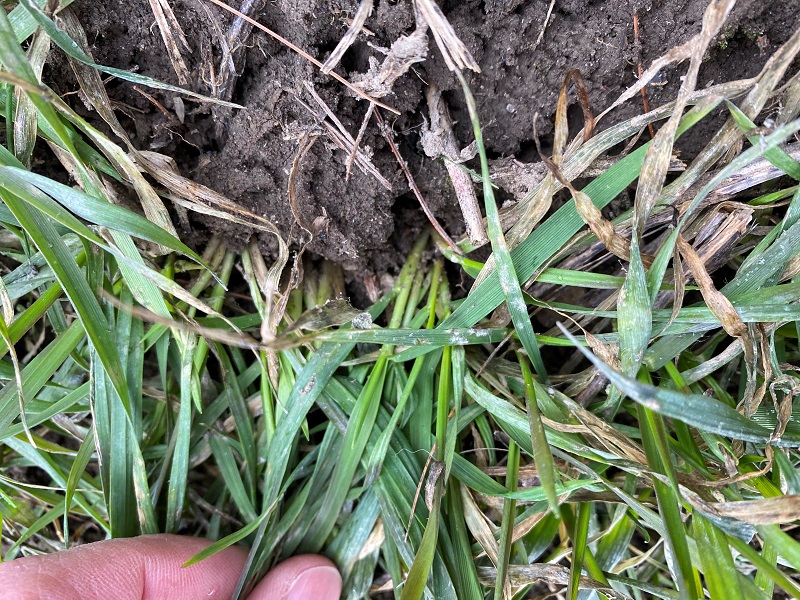
With the snow cover having disappeared in many regions, red clover has been frost seeded into some wheat fields. It is important to note that broadcasting should only occur when most of the snow has melted on the field. Optimum timing would be as early as possible when the field is still frozen, to avoid any damage to the field or crop, and it will allow the freeze thaw cycles to help promote seed to soil contact through the soil cracks for best stand establishment. Good uniform stands of red clover in wheat provides nitrogen for the following year’s corn.
Wheat fields are beginning to green up and farmers will be scouting their fields to assess stands for winter survival and populations. Thin fields will be receiving their first application of nitrogen soon to help them tiller out better as to take advantage of the warmer weather when it arrives. Split applications of nitrogen allow for better utilization of nitrogen when the crop needs it the most. If you have thick stands on well fertile ground, you may want to consider cropping plans to help prevent yield loss from diseases and lodging. Fungicide and growth regulator considerations should be investigated and planned for before problems arise.
If your winter wheat is coming out of dormancy, and is not looking very good, perhaps from being planted late in the fall, planted too shallow, poor winter hardiness, or from being covered by ice or water in the winter, it may be worth doing a stand assessment. Stand assessments should be done once there has been a week or two of warm weather. When assessing, ensure that the plants that are being counted are healthy and have a good root system that is well rooted in the soil.
If you are considering ripping up a wheat stand use the chart below (Determining Yield Potential for Various Plant Stands) to help give a potential yield of lower plant stands. If you decide to keep the stand, just remember to manage the stand to help increase tillering.
In some areas of the province, there are reports of snow mould in winter wheat fields. For more information https://cropprotectionnetwork.org/resources/articles/diseases/snow-molds-of-wheat
Determining Yield Potential for Various Plant Stands
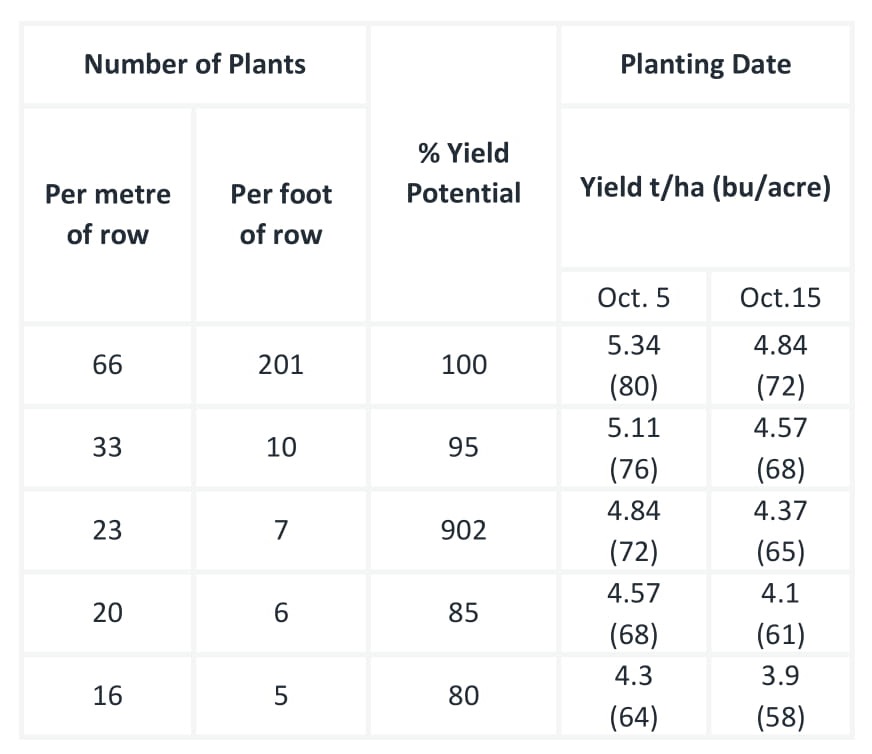
1Full stand.
223 plants/m (7 plants/ft) of row, healthy and evenly distributed plants.


















